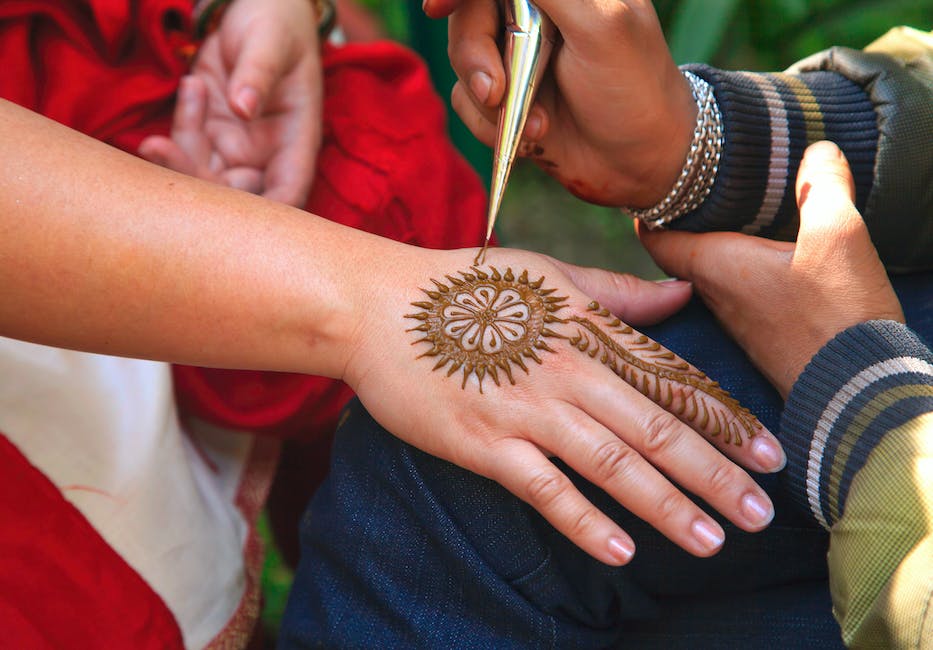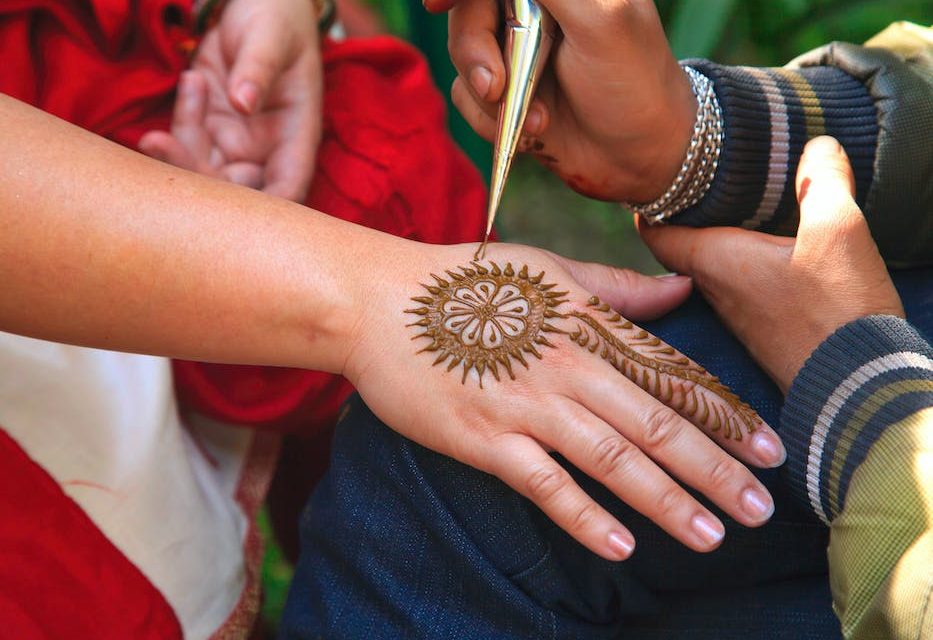Table of Contents
Unveiling the timeless artistry of henna, mirroring the enduring mark of influential leadership.
Introduction
Henna holds significant cultural importance in Arab societies, serving as a symbol of beauty, celebration, and tradition. Its application on the skin, particularly during special occasions and ceremonies, has deep-rooted historical and social significance. This essay explores the cultural significance of henna in Arab societies and draws parallels with the concept of leadership indelibility, highlighting the enduring impact and influence that both henna and effective leadership possess within these societies.
The Historical Origins of Henna in Arab Societies

The historical origins of henna in Arab societies can be traced back thousands of years. Henna, a natural dye derived from the leaves of the henna plant, has played a significant role in Arab culture, particularly in the realm of beauty and celebration. The use of henna as a form of body art has deep cultural roots and holds great significance in Arab societies.
The practice of using henna as a form of body adornment dates back to ancient times. It is believed to have originated in the Arabian Peninsula and spread throughout the Arab world. Henna was not only used for decorative purposes but also had medicinal properties and was used to treat various ailments. Its use as a cosmetic and healing agent can be found in ancient texts and manuscripts.
In Arab societies, henna is commonly associated with celebrations and special occasions. It is an integral part of weddings, religious festivals, and other joyous events. The application of henna on the hands and feet of the bride is a traditional ritual that symbolizes beauty, fertility, and good luck. The intricate designs created with henna are not only aesthetically pleasing but also serve as a form of self-expression and cultural identity.
The significance of henna in Arab societies goes beyond its decorative and celebratory aspects. It is deeply intertwined with the concept of indelibility, which is closely associated with leadership. Just as henna leaves a lasting mark on the skin, leaders leave an indelible mark on society through their actions and influence.
Leadership in Arab societies is often seen as a responsibility that carries great weight and permanence. Just as henna cannot be easily washed away, the impact of a leader’s decisions and actions cannot be easily erased. This parallel between henna and leadership indelibility highlights the cultural significance of henna in Arab societies.
Furthermore, the application of henna requires patience, skill, and attention to detail. Similarly, effective leadership requires these qualities. Leaders must carefully consider their actions and decisions, taking into account the long-term consequences. The intricate designs created with henna reflect the intricate nature of leadership, where every decision and action has a ripple effect on society.
Moreover, henna is a communal activity that brings people together. The process of applying henna often involves family and friends gathering to celebrate and bond. Similarly, leadership in Arab societies is not an individual endeavor but a collective responsibility. Leaders are expected to foster unity, promote social cohesion, and bring people together for the greater good.
In conclusion, the historical origins of henna in Arab societies can be traced back thousands of years. Its use as a form of body art and its association with celebrations and special occasions have deep cultural roots. The significance of henna goes beyond its decorative and celebratory aspects, as it is closely linked to the concept of leadership indelibility. The parallel between henna and leadership highlights the lasting impact leaders have on society and the qualities required for effective leadership. Furthermore, henna serves as a communal activity that brings people together, reflecting the collective responsibility of leadership in Arab societies.
Symbolism and Meanings of Henna in Arab Culture
Henna, a natural dye derived from the henna plant, has been an integral part of Arab culture for centuries. Its significance goes beyond its use as a decorative art form; it is deeply rooted in the traditions and beliefs of Arab societies. The symbolism and meanings associated with henna are multifaceted, reflecting the values and aspirations of the Arab people.
One of the most prominent meanings of henna in Arab culture is its association with celebration and joy. Henna is often applied during weddings, religious festivals, and other festive occasions. It is seen as a way to enhance beauty and express happiness. The intricate patterns and designs created with henna are a visual representation of the joyous spirit that permeates these events.
In addition to its celebratory connotations, henna also holds a spiritual significance in Arab societies. It is believed to have protective and healing properties, and is often used in rituals and ceremonies. Henna is thought to ward off evil spirits and bring good luck. It is also used to bless and purify individuals, particularly women, during important life events such as childbirth and coming of age ceremonies.
Furthermore, henna is deeply intertwined with the concept of femininity and womanhood in Arab culture. Women have traditionally been the primary users and practitioners of henna, passing down the art form from generation to generation. The act of applying henna is seen as a form of self-expression and a celebration of womanhood. It is a way for women to adorn themselves and assert their identity in a society that often places restrictions on their autonomy.
The patterns and designs created with henna also carry symbolic meanings. Each motif has its own significance, often representing fertility, prosperity, or protection. For example, the peacock motif is associated with beauty and grace, while the lotus flower symbolizes purity and enlightenment. These symbols are not only aesthetically pleasing, but also serve as a means of communication, conveying messages and values within the Arab community.
Drawing parallels with leadership indelibility, henna can be seen as a metaphor for the lasting impact of effective leadership. Just as henna leaves a permanent mark on the skin, great leaders leave an indelible mark on the societies they serve. Their actions and decisions shape the course of history and influence the lives of countless individuals. Like the intricate patterns of henna, their leadership is characterized by complexity, attention to detail, and a deep understanding of the cultural context in which they operate.
Moreover, henna, like leadership, is a dynamic and evolving art form. While the basic techniques and traditions remain the same, henna artists constantly innovate and experiment with new designs and styles. Similarly, effective leaders must adapt to changing circumstances and embrace new ideas in order to stay relevant and make a lasting impact.
In conclusion, henna holds great cultural significance in Arab societies. Its symbolism and meanings reflect the values and aspirations of the Arab people, encompassing celebration, spirituality, femininity, and communication. Drawing parallels with leadership indelibility, henna serves as a metaphor for the lasting impact of effective leadership. Just as henna leaves a permanent mark on the skin, great leaders leave an indelible mark on the societies they serve. The cultural significance of henna in Arab societies is a testament to the enduring power of tradition and the richness of Arab culture.
Henna as a Form of Self-Expression and Identity in Arab Societies
Henna, a natural dye derived from the henna plant, has been used for centuries in Arab societies as a form of self-expression and identity. This ancient art form holds great cultural significance and is deeply rooted in the traditions and customs of Arab communities. Henna is not merely a decorative element; it is a symbol of beauty, celebration, and spirituality.
In Arab societies, henna is commonly used to adorn the hands and feet of women during special occasions such as weddings, religious festivals, and other significant events. The intricate patterns and designs created with henna are not only visually stunning but also serve as a means of self-expression. Each design is unique and reflects the individual’s personality, creativity, and cultural heritage.
Henna is also a powerful symbol of identity in Arab societies. It is a way for individuals to connect with their roots and showcase their cultural heritage. The designs often incorporate traditional motifs and symbols that hold deep meaning within the community. For example, geometric patterns are commonly used to represent unity and harmony, while floral motifs symbolize beauty and fertility. By adorning their bodies with henna, individuals are proudly displaying their Arab identity and affirming their place within the community.
Furthermore, henna is not limited to women; men also participate in this cultural practice. While the designs may differ, the underlying significance remains the same. Men often opt for simpler and more geometric patterns, reflecting their own unique style and masculinity. This inclusivity highlights the importance of henna as a unifying cultural tradition that transcends gender boundaries.
Beyond its aesthetic appeal, henna holds a spiritual significance in Arab societies. It is believed to bring good luck, ward off evil spirits, and protect against the evil eye. The application of henna is often accompanied by prayers and blessings, creating a sense of spiritual connection and reverence. This spiritual aspect further reinforces the cultural significance of henna and its role in Arab societies.
Drawing parallels with leadership indelibility, henna can be seen as a metaphor for the lasting impact of effective leadership. Just as henna leaves a lasting mark on the skin, great leaders leave an indelible mark on the hearts and minds of their followers. Their influence and guidance shape the course of history and inspire future generations. Like the intricate patterns of henna, effective leaders create a vision that is both visually captivating and deeply meaningful.
Moreover, henna, like leadership, is a dynamic and evolving art form. While the basic principles remain the same, the designs and techniques have evolved over time. Similarly, leadership styles have evolved to adapt to changing societal needs and challenges. Just as henna artists experiment with new patterns and incorporate modern elements, leaders must be adaptable and open to innovation.
In conclusion, henna holds immense cultural significance in Arab societies as a form of self-expression, identity, and spirituality. It is a powerful symbol of beauty, celebration, and tradition. The intricate designs created with henna reflect the individual’s personality and cultural heritage, while also serving as a means of connecting with one’s roots. Henna is a unifying practice that transcends gender boundaries and brings people together in celebration. Drawing parallels with leadership indelibility, henna serves as a metaphor for the lasting impact of effective leadership. Just as henna leaves a lasting mark, great leaders leave an indelible mark on the hearts and minds of their followers. Both henna and leadership are dynamic and evolving, adapting to changing times while staying true to their core principles.
Henna as a Metaphor for Leadership Indelibility in Arab Communities
Henna, a natural dye derived from the henna plant, has been used for centuries in Arab societies for various cultural and religious purposes. It is commonly associated with celebrations and rituals, such as weddings and religious festivals. However, henna holds a deeper significance in Arab communities, serving as a metaphor for leadership indelibility.
In Arab societies, leadership is highly valued and respected. Leaders are expected to be strong, wise, and unwavering in their commitment to their people. Just as henna leaves a lasting mark on the skin, leaders leave an indelible mark on the hearts and minds of their followers.
Henna, when applied to the skin, creates intricate and beautiful designs that symbolize beauty, femininity, and celebration. Similarly, leaders are expected to inspire and uplift their communities, leaving a positive and lasting impact. The intricate patterns of henna reflect the complexity of leadership, as leaders must navigate through various challenges and make difficult decisions.
Furthermore, henna is often applied during significant life events, such as weddings and childbirth. These events mark important milestones in a person’s life, just as leadership positions mark significant milestones in a leader’s journey. The application of henna during these events signifies the transition into a new phase of life, just as leaders transition into their roles with a sense of purpose and responsibility.
Moreover, henna is a communal activity, often applied by skilled artists or family members. This communal aspect of henna mirrors the collaborative nature of leadership in Arab societies. Leaders are expected to work closely with their communities, listening to their needs and involving them in decision-making processes. Just as henna is applied with care and precision, leaders must approach their roles with the same level of attention and dedication.
Additionally, henna is known for its temporary nature. The dye fades over time, eventually disappearing completely. This transience serves as a reminder that leadership is not permanent and that leaders must be accountable to their communities. Just as henna fades, leaders must be willing to step aside when their time in office is over, allowing new leaders to emerge and continue the work.
Furthermore, henna is deeply rooted in tradition and culture. It has been passed down through generations, with each design carrying its own unique meaning. Similarly, leadership in Arab societies is often inherited or passed down within families or tribes. This continuity ensures the preservation of cultural values and traditions, as leaders carry the responsibility of upholding and promoting their cultural heritage.
In conclusion, henna holds a significant cultural and metaphorical value in Arab societies. It serves as a symbol of leadership indelibility, representing the lasting impact leaders have on their communities. Just as henna leaves a mark on the skin, leaders leave an indelible mark on the hearts and minds of their followers. The intricate patterns of henna reflect the complexity of leadership, while its temporary nature reminds leaders of their accountability. The communal aspect of henna mirrors the collaborative nature of leadership, and its deep-rooted tradition parallels the inheritance of leadership within Arab communities. Overall, henna serves as a powerful metaphor for leadership indelibility in Arab societies.
Q&A
1. What is the cultural significance of henna in Arab societies?
Henna holds cultural significance in Arab societies as it is used for various celebrations and rituals, such as weddings, births, and religious festivals. It symbolizes joy, beauty, and blessings.
2. How does henna drawing parallel with leadership indelibility?
Henna’s indelible nature, once applied, represents the concept of leadership indelibility. Just as henna leaves a lasting mark on the skin, leaders aim to leave a lasting impact on their communities or organizations.
3. What are some parallels between henna and leadership?
Both henna and leadership involve a process of careful planning and execution. They require skill, creativity, and attention to detail. Additionally, both henna and leadership have the ability to bring people together and create a sense of unity.
4. How does henna contribute to the cultural identity of Arab societies?
Henna plays a significant role in shaping the cultural identity of Arab societies. It is deeply rooted in traditions and customs, reflecting the values, beliefs, and heritage of the Arab people. Henna serves as a visual representation of cultural pride and identity.
Conclusion
In conclusion, the cultural significance of henna in Arab societies is deeply rooted and holds various symbolic meanings. It serves as a form of self-expression, celebration, and a way to connect with tradition and heritage. Drawing parallels with leadership indelibility, henna represents the lasting impact and influence that leaders have on their societies. Just as henna leaves a lasting mark on the skin, leaders leave an indelible mark on the collective consciousness of their communities. The cultural significance of henna in Arab societies highlights the importance of preserving and honoring traditions, while also recognizing the enduring impact of effective leadership.





